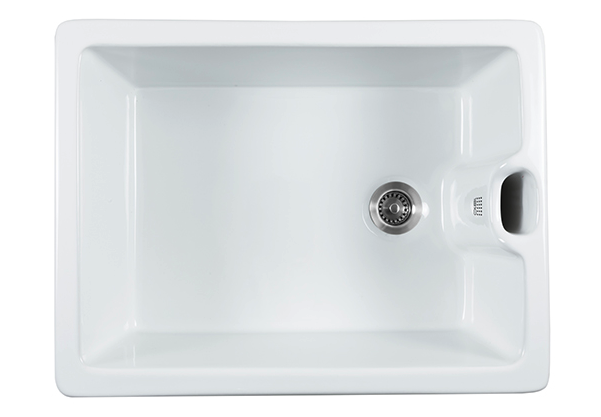What Is The Difference Between A Belfast And A Butler Sink?

When it comes to choosing a sink for your kitchen, the decision is often more complex than it initially seems.
Among the myriad of choices, two names frequently pop up in conversations about traditional kitchen sinks: Belfast and Butler.
While they may look similar at first glance, there are several key differences between these two styles.
In this article, we will quickly look into the origins, design elements, and the practical implications of choosing either a Belfast or Butler sink for your kitchen.
Click here to view our range of Belfast Sinks for sale.
Origins and Historical Background
Belfast Sinks
The Belfast sink originated, as the name suggests, in Belfast, Northern Ireland.
A city known for its abundant freshwater resources, there was no need to be conservative with water usage in Belfast homes in the past.
As a result, these sinks were traditionally designed with an integrated overflow system.
This meant that if someone inadvertently left the taps running, excess water could escape through the overflow instead of flooding onto the kitchen floor.
Butler Sinks
Butler sinks, in contrast, hail from London. Unlike Belfast, London had less readily available freshwater supplies.
The Butler sink design, therefore, typically does not include an overflow, a factor that encouraged more mindful water usage in order to avoid wastage.
Click here to view our range of Belfast Sink Waste.
Design Characteristics and Differences
Belfast Sinks
Belfast sinks are characteristically deep.
Their generous dimensions made them ideal for a range of kitchen tasks, from washing large cooking pots to soaking laundry.
The signature feature of a Belfast sink is its 'Weir' overflow system, a detail born out of Belfast's historical abundance of freshwater.
Butler Sinks
Butler sinks, on the other hand, are typically shallower than their Belfast counterparts.
They lack the 'Weir' overflow, reflecting the need for water conservation in their place of origin.
The design of Butler sinks is often viewed as more versatile, complementing both traditional and modern kitchens with their clean, simple lines.
Click here to view our range of Taps for Belfast Sinks.
Choosing Between a Belfast and a Butler Sink
When choosing between a Belfast and a Butler sink, aesthetics, practicality, and the existing style of your kitchen should all play a part.
The depth of a Belfast sink might be advantageous if your kitchen activities often involve large pots and pans, while the more compact and streamlined Butler sink might be a better fit for smaller kitchens or utility rooms.
In terms of materials, both Belfast and Butler sinks are commonly crafted from hard-wearing, heat-resistant materials like fireclay or porcelain.
Their robust construction ensures that they can withstand heavy usage, and their timeless design ensures they remain a stylish choice for many years.
Click here to view our range of Accessories for Belfast Sinks.
What Kind Of Kitchen Would Suit A Belfast Sink?
Belfast sinks, with their timeless design and functional appeal, can suit a range of kitchen styles, but they tend to complement certain designs particularly well.
- Traditional or Country-Style Kitchens: The charm of a Belfast sink naturally aligns with the aesthetics of traditional or country-style kitchens. Their depth and prominent front panel, often known as an "apron front", offer a robust, farmhouse feel that adds a touch of rustic charm. When coupled with wooden countertops or painted cabinetry, a Belfast sink can truly become the centrepiece of a country-style kitchen.
- Shaker Kitchens: Belfast sinks also complement the simplicity and functionality of Shaker kitchens. Shaker design principles emphasise utility and eschew unnecessary embellishment, which mirrors the practical and straightforward design of a Belfast sink.
- Industrial Kitchens: Although Belfast sinks are often associated with more traditional settings, they can also fit seamlessly into an industrial kitchen design. Their hard-wearing construction and generous size match well with other robust, industrial elements such as exposed brickwork, stainless steel appliances, and rugged wood or concrete surfaces.
- Modern Kitchens: While at first it might seem counterintuitive, a Belfast sink can add a striking focal point in a modern kitchen. When contrasted with sleek cabinetry, minimalistic decor, and modern appliances, a Belfast sink can add a touch of warmth and texture, preventing the kitchen from feeling too sterile.
- Cottage Kitchens: The Belfast sink is a natural fit for a cosy cottage kitchen. It complements other quaint and homey features like open shelving, freestanding furniture, and vintage accessories.
In essence, while Belfast sinks lend themselves best to traditional, rustic, or cottage-style kitchens, their timeless appeal allows them to be incorporated into various kitchen designs.
Whether you have a modern or an industrial kitchen, a Belfast sink can be a distinctive addition that blends functionality with style.
What Kind Of Kitchen Would Suit A Butler Sink?
Butler sinks, like their Belfast counterparts, are versatile in their design and functionality, making them suitable for a variety of kitchen styles.
- Country Kitchens: Butler sinks are often associated with country or farmhouse style kitchens, where their rustic charm and substantial size add to the homely and traditional feel of these spaces. They blend well with wooden cabinets, open shelving, and the generally relaxed and welcoming aura of a country kitchen.
- Contemporary Kitchens: Despite their traditional roots, butler sinks can make a striking addition to contemporary kitchens as well. The clean lines and simple form of a butler sink can complement the minimalist aesthetics of a modern kitchen. Pairing a butler sink with sleek fittings, modern appliances, and minimalist decor can create a pleasing contrast.
- Shaker Kitchens: Butler sinks fit well in Shaker-style kitchens, which prioritize functionality and understated design. The clean and simple form of a butler sink aligns with the Shaker design philosophy, contributing to a harmonious and practical kitchen space.
- Victorian Kitchens: Butler sinks were originally used in Victorian-era butler's pantries, so they fit perfectly in a kitchen inspired by this period. Their historic charm complements the ornate woodwork, bold colours, and antique accessories often found in Victorian-style kitchens.
- Industrial Kitchens: With their robust construction and simple design, butler sinks can also fit comfortably in industrial-style kitchens. When combined with exposed brick, stainless steel, and rugged surfaces, a butler sink adds a functional and visually interesting element to the space.
While butler sinks are an ideal match for country or traditional kitchens, they can also be a unique feature in contemporary, Shaker-style, Victorian, or industrial kitchens.
Regardless of your kitchen style, a butler sink can bring a blend of historical charm and practicality to your space.
Some Points of Advice from an Experienced Kitchen Fitter and Manufacturer
For well over twenty years, I have been working in the kitchen industry.
I have fitted hundreds of kitchens myself and also manufactured many hundreds more at my factory.
So, it’s fair to say I have some experience and expertise when it comes to anything related to kitchens!
If you have enough room, I would always suggest a Belfast sink over a Butler as I think they look better and give you more room for your washing up.
Final Notes on the Difference Between Butler Sinks and Belfast Sinks
While Belfast and Butler sinks share many similarities, their historical origins have led to distinctive design characteristics that differentiate the two.
Both are charming, functional, and enduring options that would be a valuable addition to any kitchen.
The choice between them ultimately depends on personal preference, practical requirements, and the design of your kitchen.
Whichever you choose, both Belfast and Butler sinks bring with them a piece of history and a classic touch that can enhance the heart of any home.


